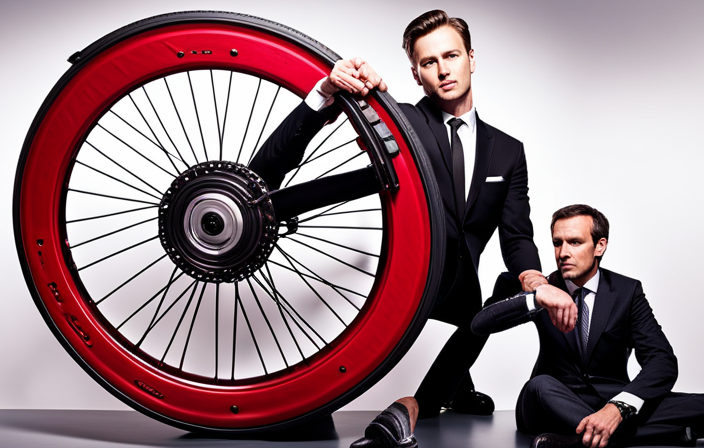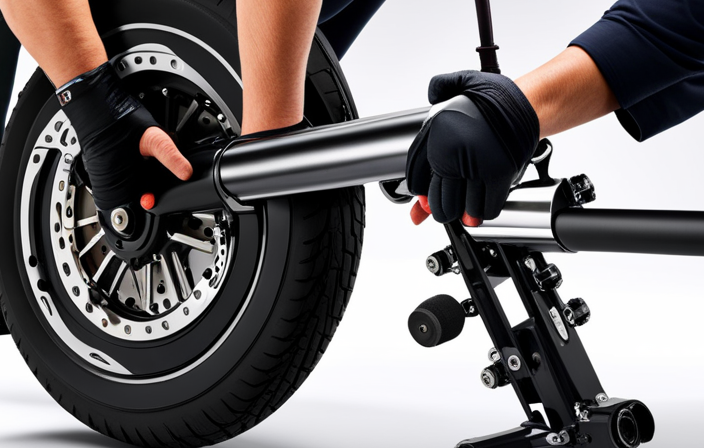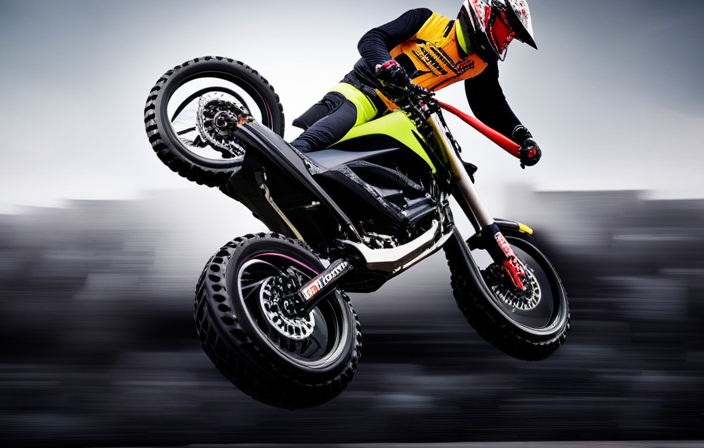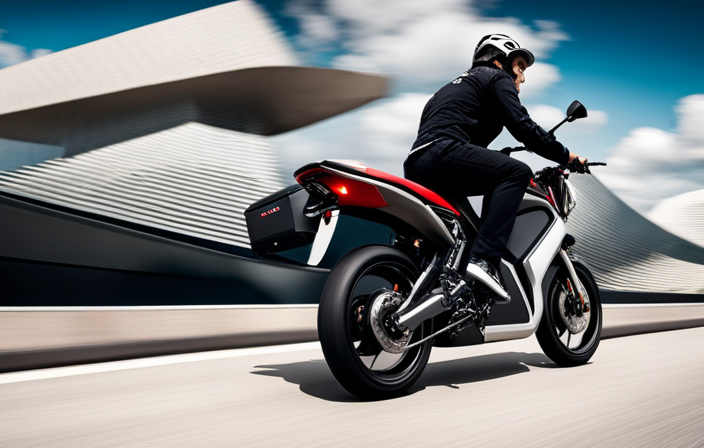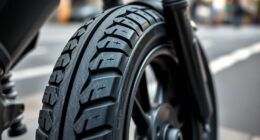So, you’ve decided to take on the challenge of assembling your own electric rear bike wheel. Well, buckle up and get ready for an exciting ride!
In this article, we’ll guide you through the step-by-step process of assembling your electric rear bike wheel with precision and ease.
From gathering the necessary tools to fine-tuning the electric assistance settings, we’ve got you covered.
So, let’s dive in and transform your ordinary bike into an electrifying powerhouse!
Key Takeaways
- Adjusting power and speed to find the optimal performance
- Fine-tuning performance by adjusting the sensitivity of the electric motor
- Ensuring component security by regularly inspecting for any issues
- Tire maintenance to enhance traction and prevent flats.
Gather the Necessary Tools and Materials
You’ll need a few tools and materials to assemble the electric rear bike wheel.
First, make sure you have a set of Allen wrenches in various sizes. These will be essential for loosening and tightening bolts during the installation process.
Additionally, you’ll need a 15mm wrench or an adjustable wrench to remove the nuts from the axle.
Don’t forget to have a tire lever on hand to help with removing the tire from the rim.
In terms of materials, you’ll need the electric rear bike wheel itself, which should come with its own motor and battery.
You’ll also need a tube and tire to fit the wheel size.
Now that you have everything ready, let’s move on to removing the rear wheel from your bicycle.
Remove the Rear Wheel from Your Bicycle
To remove the back tire, simply loosen the bolts and slide it out.
Begin by using a wrench to loosen the nuts or quick release levers that secure the wheel to the frame.
Once the nuts are loosened, lift the rear of the bike slightly off the ground and slide the wheel out of the frame’s dropouts.
Take care not to damage the derailleur or the chain during this process.
If your bike has rim brakes, you may need to also release the brake cable or deflate the tire slightly to create enough clearance.
Once the wheel is removed, assess the condition of the tire and inner tube, and replace them if necessary.
With the rear wheel removed, you are now ready to attach the motor to the rear wheel.
Attach the Motor to the Rear Wheel
Once the motor is securely fastened to the back tire, make sure to double-check that all the bolts are tightened properly. Proper installation of the motor is crucial for the smooth functioning of your electric rear bike wheel.
Here are some important steps to follow:
- Ensure that the motor is aligned with the center of the rear wheel to maintain balance.
- Attach the motor to the wheel hub using the provided mounting brackets and bolts.
- Tighten the bolts using a wrench or socket, ensuring they are snug and secure.
By carefully following these steps, you can ensure that your motor is properly attached to the rear wheel, guaranteeing optimal performance and safety.
Once the motor is securely in place, you can move on to the next step: connecting the motor to the battery.
Connect the Motor to the Battery
Make sure that all the necessary wires are properly connected between the motor and the battery. Begin by identifying the wires coming from the motor and the battery. Typically, there will be three wires from the motor, including two power wires and one ground wire.
The battery, on the other hand, will have two power wires and one ground wire. Connect the power wires of the motor to the corresponding power wires of the battery, ensuring a secure connection. Then, connect the ground wire of the motor to the ground wire of the battery.
It is crucial to double-check the connections to ensure they are properly secured and free from any loose or exposed wires. Once you have successfully connected the motor to the battery, you are ready to move on to the next step: installing the controller and throttle.
Install the Controller and Throttle
Now that the motor and battery are connected, it’s time to install the controller and throttle. This crucial step will allow you to control the power and speed of your electric rear bike wheel. Here’s what you need to do:
- Begin by finding a suitable location for the controller and throttle on your bicycle.
- Secure the controller to the frame using zip ties or mounting brackets.
- Connect the wires from the motor to the corresponding ports on the controller, ensuring a secure connection.
- Attach the throttle to the handlebars using the provided clamp or bracket.
- Connect the throttle wires to the controller, following the color-coded instructions for proper wiring.
With the controller and throttle successfully installed, you can now move on to the next step: mounting the rear wheel back onto your bicycle, ensuring a smooth and efficient electric ride.
Mount the Rear Wheel Back onto Your Bicycle
After successfully installing the controller and throttle, it’s time to reattach the rear wheel to your bicycle.
Begin by placing the wheel into the dropouts of the frame, ensuring that the axle slots into the corresponding slots on the frame. Align the chain with the rear sprocket and slide the wheel all the way into the dropouts.
Next, tighten the axle nuts or quick-release skewer to securely hold the wheel in place. Use a wrench or Allen key to tighten the nuts or skewer, making sure they are evenly tightened on both sides.
Now that the rear wheel is securely attached, you can move on to the next step: securing the battery in a proper location.
Secure the Battery in a Proper Location
Once you’ve successfully mounted the rear wheel back onto your bicycle, it’s important to secure the battery in a proper location.
The battery is a vital component of your electric bike and needs to be securely fastened to ensure safe and efficient operation. Look for a designated battery mount on your bike frame, typically located near the rear wheel. Use the provided mounting brackets and screws to attach the battery securely to the frame.
Ensure that the battery is centered and aligned properly to maintain balance and stability while riding.
With the battery securely in place, you can now move on to the next step: connecting the wiring and testing the electric system. This will ensure that all components are functioning correctly before you hit the road.
Connect the Wiring and Test the Electric System
Before attaching the battery, make sure to connect the wiring and test the electric system to ensure everything is functioning correctly. This step is crucial in the assembly process to guarantee that the electric rear bike wheel operates smoothly and efficiently. To guide you through this process, refer to the table below for a clear understanding of the wiring connections:
| Wire Color | Connection |
|---|---|
| Red | Battery positive terminal |
| Black | Battery negative terminal |
| Green | Electric motor |
| Yellow | Brake sensor |
| Blue | Display panel |
Once the wiring connections have been made, proceed to test the electric system. Turn on the bike’s power switch and check if the motor engages smoothly when you start pedaling. Additionally, ensure that the brake sensor is working properly by applying the brakes and observing if the motor stops immediately. With the wiring connected and the electric system functioning correctly, you are now ready to adjust and fine-tune the electric assistance settings to your preferences.
Adjust and Fine-tune the Electric Assistance Settings
With the wiring connections complete and the electric system functioning correctly, you’re now ready to adjust and fine-tune the electric assistance settings to your preferences.
Follow these steps to optimize your riding experience:
-
Power Level: Choose the desired level of electric assistance. Most electric rear bike wheels offer multiple power levels, ranging from low to high. Experiment with different settings to find the one that suits your needs.
-
Speed Limit: Adjust the maximum speed at which the electric assistance will kick in. This allows you to control how fast you want to go before the motor engages. Set it according to your comfort and the local regulations.
-
Torque Sensitivity: Fine-tune the sensitivity of the electric motor to your pedaling. Increase it for a more responsive ride, or decrease it for a smoother and more natural feel.
By adjusting these electric assistance settings, you can personalize your riding experience and maximize the benefits of your electric rear bike wheel.
Now, enjoy your new electric bike!
Enjoy Your New Electric Bike!
Now that everything is set up, it’s time to fully enjoy your brand new electric bike!
Before you start riding, make sure all the components are securely fastened and the tires are properly inflated. Check that the electric assistance system is functioning correctly by turning on the power and testing the throttle and pedal assist modes.
Familiarize yourself with the controls and understand how to adjust the assistance levels according to your preferences and the terrain you’ll be riding on. Remember to always wear a helmet and follow traffic rules for your safety.
Take your new electric bike for a spin and feel the thrill of effortless pedaling and increased speed. Explore new routes and enjoy the freedom that comes with this innovative mode of transportation.
Happy riding!
Conclusion
Congratulations! You’ve successfully assembled your electric rear bike wheel.
Now, you can effortlessly glide through the streets with the power of electricity at your fingertips.
Who needs the joy of pedaling when you can simply twist the throttle and let the motor do all the work?
Say goodbye to the satisfaction of a challenging uphill climb and hello to the convenience of a motorized ride.
It’s truly a remarkable feat of engineering that allows us to effortlessly conquer the world around us.
Enjoy your new electric bike, and remember to always embrace the irony of progress.
